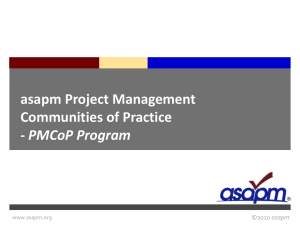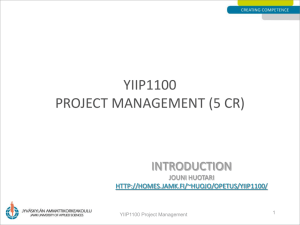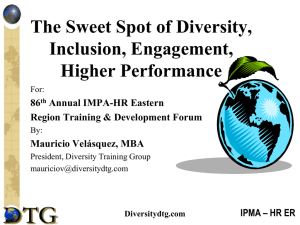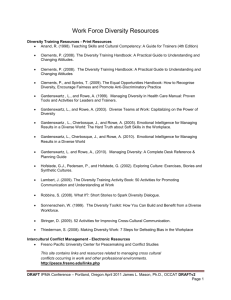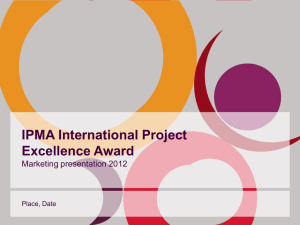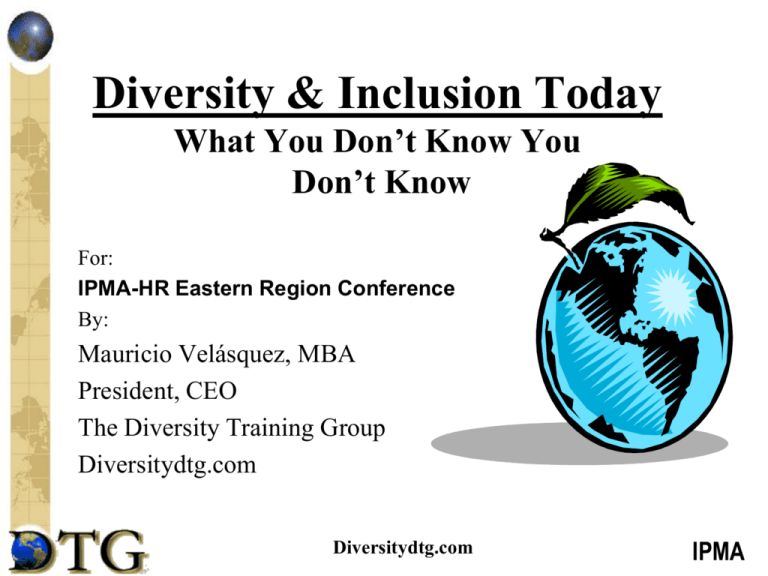
Diversity & Inclusion Today
What You Don’t Know You
Don’t Know
For:
IPMA-HR Eastern Region Conference
By:
Mauricio Velásquez, MBA
President, CEO
The Diversity Training Group
Diversitydtg.com
Diversitydtg.com
IPMA
Meet Mauricio Velásquez, MBA
Mauricio Velásquez is the President and CEO of The
Diversity Training Group (DTG) in Herndon, VA. Mauricio
serves as a diversity strategy consultant, diversity and
inclusion trainer, sexual harassment prevention trainer,
executive coach, mentoring trainer, and expert witness.
DTG’s clients include small and large organizations and
public and private entities. SSA, OMB, NIST, NTIA, USCIS,
HHS, and USPS are just some of our current federal clients.
White House, DOI, USIA, USDA, DHS, US Navy, US Coast
Guard are some of our past clients.
Mauricio has trained over a half million participants in every
state but North Dakota and his work and life have taken him
to more than seventy countries. Mauricio holds a BA from
UVA and an MBA from GWU. Married to Kelly with 3 kids.
Diversitydtg.com
IPMA
Mauricio’s Mission
Provoke Thought
Facilitate Discussion & Learning
Surprise You
Entertain You
Add Value
Provide Subject Matter Expertise
Have Fun
-Triple InvestmentDiversitydtg.com
IPMA
A Workshop on….
Treatment, Respect
Professionalism, Trust
Engagement to Higher Performance
Current Events
Management, Supervision, Leadership
Parenting
Diversitydtg.com
IPMA
Opening Remark
What You Don’t
Know You Don’t
Know
(DKDK)
What You
Don’t Know
(DK)
What You Know
(K)
Diversitydtg.com
IPMA
Intent vs. Impact
Intent
(what you meant)
vs.
Impact
(what you actually said)
Diversitydtg.com
IPMA
Is there a relationship?
Being Inclusive
(Welcoming)
Valuing Diversity
(Valuing difference
of opinion,
background)
Being Respectful
(Treated with
Respect, Dignity)
Diversitydtg.com
Engagement
Perform at Higher
Level
IPMA
Diversity
When you hear this term what “pops” into your head?
What are all of the differences (and similarities) in our
workplace? In our ranks, our peers, colleagues,
travelers.
What is Inclusion? What does it mean to be inclusive?
Diversitydtg.com
IPMA
Dimensions of Diversity
Language
Military
Experience
Education
Religion
Age
Gender
Work
Style
Family
Status
Income
Sexual
Orientation
Ethnic
Heritage
Mental/
Physical
Abilities
Race
Work
Experience
Individual
Geographic
Location
Communication
Style
Operational Role
and Level
Group
Organizational
Affiliation
Diversitydtg.com
IPMA
Dimensions of Diversity
Military
Experience
Language
Education
Religion
Work
Style
Age
Gender
Income
Mental/
Physical
Abilities
Sexual
Orientation
Family
Status
Ethnic
Heritage
Work
Experience
Race
Communication
Style
Geographic
Location
Operational Role
and Level
Diversitydtg.com
IPMA
Dimensions of Diversity
Indivi
Individual
dual
Group
Organizational
Affiliation
Diversitydtg.com
IPMA
Are you Inclusive?
Diversitydtg.com
IPMA
The Lunch Date
Adam Davidson
Screen Writer/Director
This was his thesis to get his degree in
film from AFI – American Film Institute,
New York City
Won many awards
Filmed in 1990
On You Tube – if you can’t find it, ask
your kids to find it
Diversitydtg.com
IPMA
To be an Inclusive Change Agent
Understand the Myths of D & I
Understand what a D & I is - so when you come
across it – you act
Address present D & I issues and proactively
anticipate emerging D & I issues
Hold people accountable (peers, direct reports)
“We all have a shared responsibility to each other
– we are all in this together!”
Diversitydtg.com
IPMA
Major Myths of Diversity & I
1. Diversity is a problem. No, it is an opportunity.
2. Diversity is HR’s responsibility. No, it is my responsibility,
on all of us.
3. Diversity is just about race and gender. No, it is much
broader than that.
4. Diversity is about minorities and women in the workplace.
No, diversity is about your (employees) internal and
external (prospective clients) customers.
5. Diversity is about exclusivity. No, it is about inclusivity. It
is about retaining your employees and clients.
6. Diversity is just another fad. Have you seen the numbers?
7. Diversity is another version of EEO/AA. Wrong! EEO/AA
is government mandated. Diversity is workplace driven.
Diversitydtg.com
IPMA
A Diversity Issue Exists…
When an issue (policy or business practice—formal, informal,
internal, or external) has a different impact on a particular
group (i.e., impact on men vs. women, black vs. white,
American vs. foreigner, urban vs. rural background)
When it happens more frequently to a particular group (i.e.,
different groups have dramatically different “numbers”—
turnover, terminations, promotions, few or no role models)
When it is more difficult for one group to overcome
(upward mobility for a particular group within an organization,
i.e.,“glass ceilings”)
Page 14 in your workbook – out of order in PPT for emphasis
Diversitydtg.com
IPMA
A Diversity Issue Can’t Be Ignored
A diversity issue exists where the policy or business practice
has an impact exclusive of difference (not inclusive of
difference). Is there a trend or pattern (intentional or
unintentional)?
Having a diversity issue is not necessarily a bad thing.
Doing nothing about it given you have knowledge of the
issue is where organizations go wrong (negligence). Being
in denial about these issues do not make them go away.
Ignorance is not bliss inside or outside the courtroom.
The question is why do we have this issue and how can we
take action to correct it or improve the situation. Study or
investigate, identify root cause(s) and identify solutions and
execute! Don’t ignore the issues or be in denial about their
existence.
Diversitydtg.com
IPMA
Addressing Diversity Issues – 1 opportunity @ a time
Step
?
Action
Example
Identify and agree
on the problem
(consensus) Ask the
right questions.
Ask for the facts
Verify the information
Decide what else you need to
know
“Help me understand exactly”
“Let me make sure this is recorded
correctly”
“I will be able to help you better if I
know…”
Conduct problemcause analysis to
identify a specific
problem and its
cause
Restate the problem in simple
terms
Get agreement on the problem
and its importance/impact
“So, the basic issue is…”
“It seems we agree it is important
to fix this because…”
Identify
solutions/alternative
s
Ask what can be done to solve the
problem
Suggest other options for
consideration
Tell them what you can do
“What ideas do you have on how
this can be fixed?”
“In similar situations we have..”
“I really wish we could do exactly
what you suggested. However,
according to…, we must…”
Diversitydtg.com
IPMA
Addressing Diversity Issues – 1 opportunity @ a time
Step
Action
Example
Implement solutions/take
action with the help of the
customer
Ask for their cooperation
Tell them what you will do
Suggest how they can help,
now and the next time
“I’ll need your help to…”
“Here is what I can do…”
“To get this resolved quickly,
I’ll need you to…, and if this
should happen again,
please…”
End with an agreement and a
thank you. Monitor and
follow up on the situation
Summarize what will be done,
and by whom
Thank the customer for
cooperation and help
Promise to follow up to ensure
the solution really worked
“Can I assume that we agree
on…?”
“Thank you for being so
cooperative in helping us to
solve this problem.”
“I will call you in a week to be
sure the situation is resolved.”
Diversitydtg.com
IPMA
What do you think?
Is your biggest diversity and inclusion issue or
challenge or obstacle?
What is the root cause(s) behind this issue?
How can you address it? What are potential
solutions and prioritize them?
“Let’s look at some best practices. You don’t
have to recreate the wheel – just take
someone else’s tire and put a white wall on
it!”
- MV
Diversitydtg.com
IPMA
Nationwide Best Practices
Sources:
American Express Benchmark Study
Business Week Special Sessions
The Conference Board Best Practices Publications
Fortune’s Best Practices Lists/Articles
Towers-Perrin North-American Diversity Best Practices
Study
US Department of Labor and other US Government
Studies
Diversitydtg.com
IPMA
What is working
– critical success factors
STRATEGIC
I. Visible, supportive and fully-committed senior
leadership
II. Diversity strategy/plan developed & aligned with
organization’s strategic plan
III. Internal and external communications improved
IV. Employee involvement and assessment
V. Recruitment and retention activities improved
VI. Measurement, metrics and follow through emphasized
VII.Constant benchmarking and continuous improvement
of diversity strategy and plan
All of this is of greater importance with
President Obama’s executive order!!
Diversitydtg.com
IPMA
DTG solutions or successes
NIST
Training agency personnel on Diversity and Inclusion
Offering complimentary and more specific training, Sexual Harassment Prevention
Training, Toxic Employee-Workplace
Conducting agency-wide assessments or “spot audits” or investigations
Executive Coaching
OMB, SSA
Ensuring Diversity Council is effective and has high impact (stood up first meeting
in response to Obama Executive Order)
Weaving Diversity and Inclusion into the “Fabric of Agency”
Diversity and Inclusion Training as part of On-boarding, new hire orientation –
short module on Diversity and Inclusion
Designing and developing video based modules to show to all employees (100,000
plus)
Did Age Diversity Training (OMB) and strategy and Stood Up first Diversity
Committee Meeting (in response to Obama Executive Order)
Diversitydtg.com
IPMA
More successes
USCIS
Making sure Diversity and Inclusion is in Supervisory, Management and Leadership
Training Curriculum
Making Diversity and Inclusion part of Core Values – linking conversation to core
vales
USPS
Conducting high level Diversity and Inclusion Leadership Training (weaving D & I
into all of their training and development) – should not be “set apart and by itself”
Political appointees, SESers
NTIA
Training all agency personnel on Diversity and Inclusion (mandatory)
Working with Diversity Committee (collaborate and partner with them) - mentoring
US Navy (SG, JAG)
Diversity and Inclusion Training worldwide – from Guantanamo Bay, Cuba to
Guam to Italy, Spain and all US Navy bases (hostile or difficult audiences)
Diversitydtg.com
IPMA
Why?
Is this topic, this session so important?
Because “Status Quo” is not working!
- Doing the same things you have always done
with your human resources, your talent, and
expecting better results is organizational
suicide!
Diversitydtg.com
IPMA
Action Plan
How can I create an inclusive work
environment?
How can I use what I have learned
in this session in my organization
and beyond?
Diversitydtg.com
IPMA
In Closing….
Thank you for your time, consideration and
participation today!
If you love the class – tell everybody about it,
if you hated it, please keep it to yourself
(but put your comments in the evaluation)
Comments, feedback, input – put in
evaluation please!!!!
Diversitydtg.com
IPMA
What can I do?
Knowledge – Action = Nothing
Don’t act – nothing happens!
There is no such thing as “innocent
bystanders.”
Diversitydtg.com
IPMA
For more information…
CONTACT:
The Diversity Training Group
692 Pine Street
Herndon, VA 20170
Tel. 703.478.9191
Fax 703.709.0591
Mauriciov@diversitydtg.com
Mauricio Velásquez, MBA - President
Diversitydtg.com
IPMA

